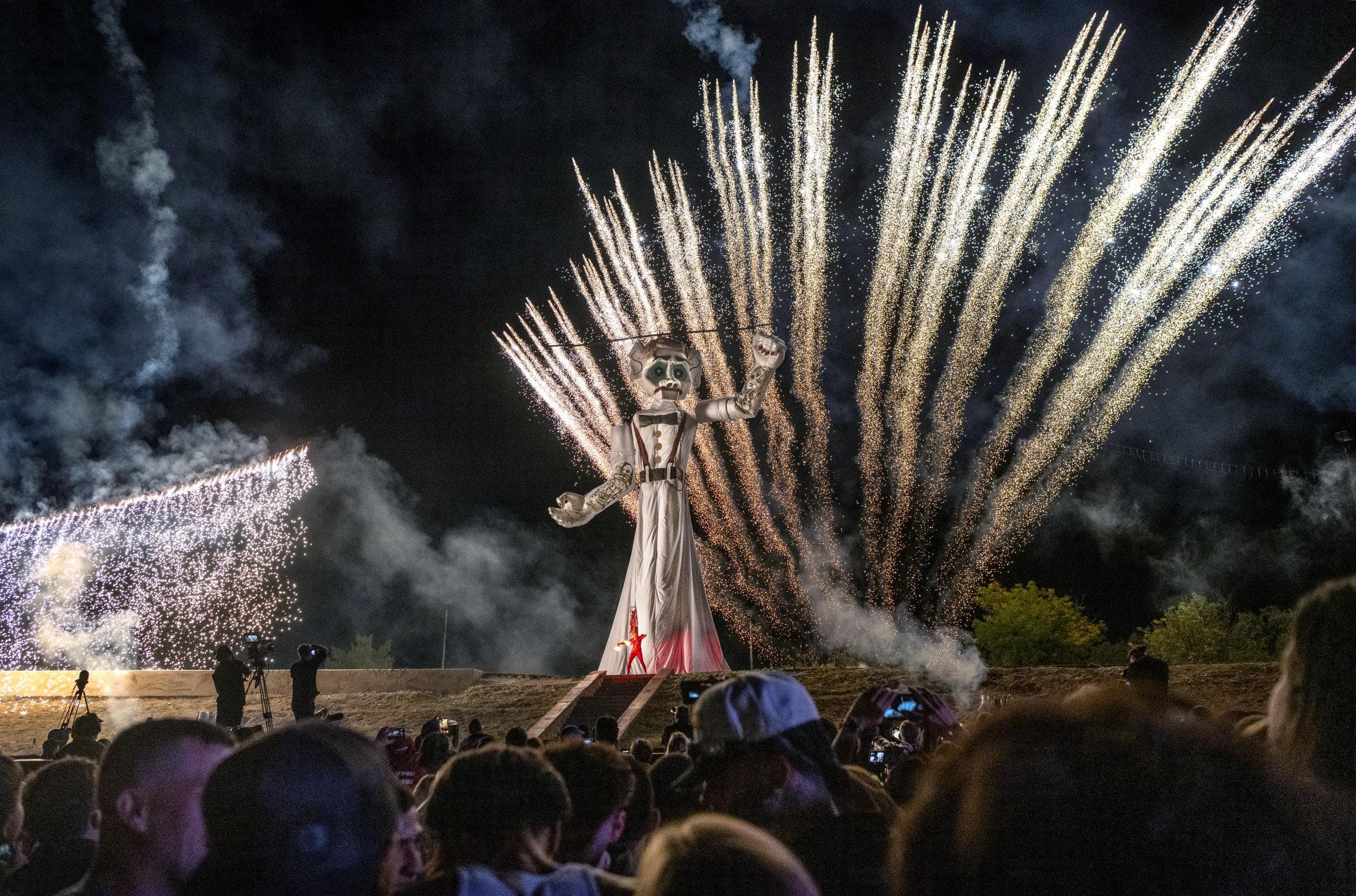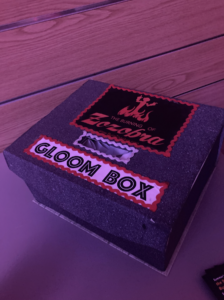
Gloom is inevitable. But you can vanquish it at the annual burning of Zozobra. Raymond Sandoval, event chair of the beloved Santa Fe ritual, invites us all to throw away our woes and begin anew. Courtesy of Eddie Moore/Albuquerque Journal.
Grievances, everyday annoyances, unexpected sorrows. A loved one leaves by choice or by a visit from the Grim Reaper. A financial burden turns life upside down. Even a flat tire at the wrong time can send someone over the emotional edge. It’s no wonder we annually feel an urgent need to make New Year’s resolutions, hoping for better outcomes.
What if there were a ritual for releasing the woes, anxieties, and grief that plague us despite our best intentions? Santa Fe, New Mexico, “the City Different,” has such a tradition. Known to locals as the city’s own special New Year, the Burning of Zozobra, the original burning man who predates the Black Rock City effigy by 60 years, is our way to let go of worries and sorrow and make a fresh start.
In 1917, Will Shuster, a Philadelphia artist who worked for the Curtis Publishing Company, answered the World War I call of duty. Sent to France to organize and command an Army Message Center, he endured sleepless nights, emergency rations, and muddy trenches before being mustard gassed for his efforts. Returning home in 1919, Shuster received a diagnosis of tuberculosis, generally considered terminal in that era. His doctor noted that Shuster could stay in Philadelphia and live for perhaps a year, or he could head west to a place where he would “probably die of old age, snake bite or drinking too much bad whiskey.” Shuster took his doctor’s advice, packed up the family and moved to Santa Fe, where he proceeded to live for 50 fulfilling years.
In New Mexico, Shuster became part of a self-titled group known as Los Cinco Pintores (the Five Painters), locally christened as the “five nuts in huts,” a pointed comment on their side-by-side self-built adobe abodes and their financial challenges. When one member of the group sold a painting, all benefited from the proceeds. After one such 1923 sale, Shuster insisted that the group blow the money on a Christmas Eve night out at the new La Fonda hotel bar. Frustrated by listening to his friends’ grousing, Shuster demanded that they write down their gloomy thoughts on paper, then put the papers into a bowl and set them on fire. Though they were promptly tossed out of the bar, the act became a kindling of an idea that ignited the following year after Shuster found inspiration on a trip to Mexico during Easter time.
Accompanied by E. Dana Johnson, a prominent Santa Fe journalist and editor, while traveling Shuster witnessed a Holy Week tradition in which an effigy of Judas was paraded around a village on a donkey as people threw shoes and hissed at it. Shuster was struck by how the crowd united in solidarity against the torment and despair that the Judas figure represented. Recalling how it felt burning his gloom with his friends at La Fonda the year before, he married the two memories into a unique whole. That fall, in September 1924, he built his own 6-foot-tall effigy, filled it with glooms written on paper, and burned it in his back yard. At first, Shuster referred to the effigy as Old Man Groucher, but he and Johnson ultimately settled on naming it Zozobra, a Spanish word denoting anxiety or gloom.
From the start, Shuster was adamant that Zozobra was not a political or religious figure but instead a manifestation of the negativity that humans experience, the sorrows and hurts we inflict upon ourselves and others. By letting those thoughts and feelings be consumed in the flames that consumed Zozobra, he hoped that the tradition would help people cleanse themselves of the gloom, regrets, and sadness they carried.
Zozobra is a relative youngster in the history of Santa Fe, which boasts the oldest U.S. capitol, but the burning of a functional marionette has already become a cherished local cultural tradition, part of the personal story of countless families. Schools create Zozobra lesson plans, and people who have helped with Zozobra’s construction, stuffed it with shredded paper, or performed in the accompanying pageant ignite the same fire for participation in their own children. It’s not unusual to hear kids recite the color of Zozobra’s hair in years before they were born, and on Halloween, it’s common to see a little Zozobra at the door.
In 1964, Shuster gifted the nonprofit Kiwanis Club of Santa Fe with the rights to Zozobra. In keeping with the Kiwanis’ mission, the Santa Fe club donates net proceeds from the event to help fund local organizations that work to make life better for children. A lifelong lover of Zozobra, I’ve served as its event chair since 2012, taking over from Ray Valdez, who oversaw the burning of Old Man Gloom for more than two decades.
We’re proud to have over 70,000 people flock to Fort Marcy Park to take part in the annual burning of Zozobra. The narrative plays out the same way every time: Ostensibly invited to a party in his honor, Zozobra, also known as Old Man Gloom, gleefully attends the festivities, intent on robbing Santa Fe of its hope and happiness. Using his dark forces to cloud the minds of Santa Fe’s children, portrayed by local students, he turns these innocents into “Gloomies”—minions he can use to wreak havoc on the city. But as Zozobra and his Gloomies prematurely celebrate his intended triumph, a group of torch bearers representing townsfolk appear to counter the spreading gloom. Zozobra and the Gloomies frighten the torchbearers away. But just when it looks as though all is lost, the watching crowd begins to chant “Burn him, Burn him!”
This impassioned cry summons a Fire Spirit, who materializes to battle with Zozobra for the soul of the city. The annual clash between good and evil ends when the Fire Spirit’s flaming torches signal Zozobra’s demise under a blaze of fireworks, said by Shuster to be his way of painting the sky. United in the spiritual balm of releasing anguish and heartbreak, those witnessing this spectacle celebrate as the 50-foot-tall effigy and their sorrows become glowing embers, clearing the emotional air.
Over the past few years of devastating losses and trauma, the purging of grief that Zozobra provides has meant more than ever. While the wounds we suffer, both external and internal, never really disappear, the fellowship and goodwill that call forth the Fire Spirit serve as a reminder that, as humans, we can help one another heal the emotional burdens we carry.
The return of gloom is inevitable, as is the need to vanquish all that Zozobra represents. Because what is Zozobra but a manifestation of the spiritual struggle between light and darkness, played out in an annual drama?
Inspired by the promise made to Zozobra’s creator to present this pageant in perpetuity, Kiwanis’ commitment to the tradition is unwavering. Our volunteers are already making preparations to get next year’s ritual underway, readying Old Man Gloom to help us with sorrows to come. Zozobra will burn again.





Send A Letter To the Editors